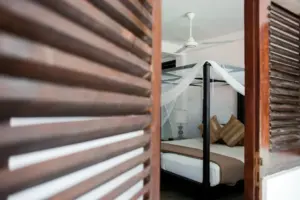
Australian scientists have unveiled a groundbreaking roof coating capable of passively cooling surfaces by up to 6°C below ambient temperatures while also extracting water from the atmosphere. This innovation, they assert, could significantly lower indoor temperatures during extreme heat events, a growing concern as heatwaves become more intense and frequent due to climate change.
The coating, developed from a porous film, can be applied to existing roofs. It works by reflecting 96% of incoming solar radiation, rather than absorbing the sun’s energy. Additionally, it boasts high thermal emittance, effectively dissipating heat into outer space when skies are clear. This phenomenon, known as passive radiative cooling, allows the coating to remain cooler than the surrounding air, even during daylight hours.
“The paint, even during the day when the sun is out, can be cooler than the air around it,” stated Prof Chiara Neto, the study’s lead author from the University of Sydney. The cool surface also facilitates the condensation of atmospheric vapor, akin to dew forming on a car overnight. “This material is able to extend the period over which dew can form by at least a couple of hours,” Neto added.
Scientific Breakthrough and Practical Application
The study, published in the journal Advanced Functional Materials, detailed a six-month trial of the prototype at the Sydney Nanoscience Hub. The researchers paired the cool paint with a UV-resistant topcoat to encourage dew droplets to roll into a receptacle. The results were promising: up to 390 milliliters of water per square meter per day could be collected for about a third of the year. For an average Australian roof of 200 square meters, this translates to approximately 70 liters of water on days conducive to dew collection.
Neto suggested that this system could complement existing water sources, particularly in remote areas or locations with limited groundwater access. “The cooling aspect and the water go hand in hand when we talk about impact,” she noted. In poorly insulated buildings, a 6°C reduction in roof temperature could lead to significant indoor cooling, particularly in many Australian homes where insulation is often inadequate.
Addressing Urban Heat and Environmental Concerns
The coating could also mitigate the urban heat island effect, where urban centers become significantly warmer than rural areas due to heat absorption by hard surfaces. However, the initial prototype used poly(vinylidene fluoride-co-hexafluoropropene), a material with environmental drawbacks that limit its scalability.
To address this, the researchers are developing a water-based paint with similar cooling properties, which they aim to commercialize. This new paint is expected to be priced similarly to standard premium paints, making it accessible for widespread use.
Expert Opinions and Future Prospects
Sebastian Pfautsch, a professor of urban management and planning at Western Sydney University, commented on the potential of cool coatings. “I expect that this will happen before 2030,” he said, noting the decade-long development of such technologies. The ability to retrofit existing buildings is particularly appealing, offering a practical solution to enhance building efficiency.
However, Pfautsch cautioned that water collection efficiency could diminish under drought conditions due to lower relative humidity. “Under drought conditions your relative humidity would also be very low,” he explained, potentially reducing the amount of water collected.
Implications and Looking Ahead
The development of this innovative roof coating represents a significant step forward in addressing the dual challenges of urban heat and water scarcity. As climate change continues to exacerbate these issues, such technologies offer a promising avenue for adaptation and resilience.
As the researchers move towards commercializing the water-based variant, the potential for widespread application grows. This could lead to a future where buildings not only contribute less to urban heat but also serve as micro water collection sites, providing a sustainable resource in times of need.
With ongoing advancements and potential market entry by 2030, this technology could play a crucial role in shaping the future of urban planning and environmental management.







